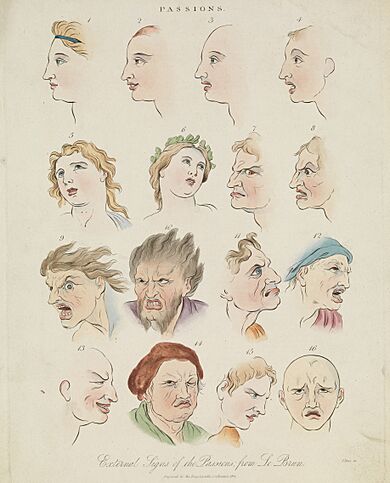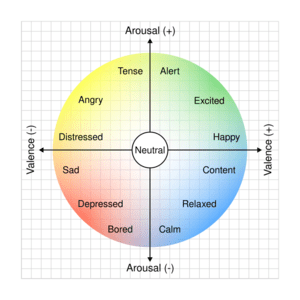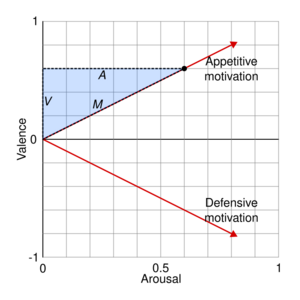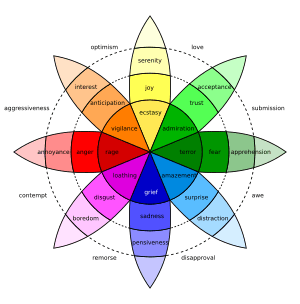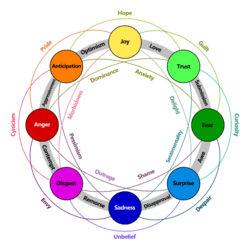Emotion classification facts for kids
Have you ever wondered how we sort and understand our feelings? Emotion classification is all about figuring out how to tell one emotion from another. Scientists who study emotions, called affective scientists, have different ideas about this.
Some think emotions are like separate, distinct feelings, each with its own special look and feel. Others believe emotions are more like a mix of different ingredients, and we can describe them using a few main qualities.
Contents
Emotions: Are They Separate Feelings?
Some scientists believe we all have a set of basic emotions that everyone around the world can recognize. These are called "discrete" emotions because they seem to have their own clear facial expressions and even affect our bodies in unique ways.
For example, a famous researcher named Paul Ekman studied people from different cultures in 1992. He found that six emotions seemed to be universal:
Ekman thought that each of these emotions has special signs, like how our face looks, that help us show them without words. He saw them as distinct categories, not just individual feelings.
Are Emotions Simple or Complex?
It feels easy to recognize emotions in ourselves and others, right? This led many to believe in these "basic" and universal emotions. But experts have debated this idea.
Some theories say that when you feel an emotion like anger or fear, your brain "triggers" it. This happens when your brain judges an event based on your goals or safety. These theories suggest that different emotions have unique biological signs. This means we should be able to tell what someone is feeling just by looking at their brain activity or body, without needing to know what they saw or what happened.
However, other theories, called "constructionist" accounts, suggest that emotions are "built" from simpler parts. Imagine emotions as a recipe. Two main ingredients might be:
- Core affect: This is how pleasant or unpleasant you feel, and how energized or calm you are.
- Conceptual knowledge: This is what you know about emotion words, like what "anger" means.
These theories believe that emotions don't have one specific spot in the brain or unique body signs. They also think that the situation or "context" is super important. It helps us understand which emotion concepts fit best.
Emotions: A Mix of Qualities?
Instead of seeing emotions as separate boxes, some researchers describe them using different qualities or "dimensions."
For example, way back in the 1600s, a philosopher named René Descartes talked about six main "passions" (emotions): wonder, love, hate, desire, joy, and sadness.
Later, in 1897, Wilhelm Wundt, who is known as the father of modern psychology, suggested that emotions could be described by three qualities:
- Pleasant or unpleasant
- Exciting or calming
- Tense or relaxed
In 1954, Harold Schlosberg also named three qualities: pleasantness-unpleasantness, attention-rejection, and level of activation.
Dimensional models try to show emotions on a map using two or three main qualities. Most of these models use:
- Valence: How pleasant or unpleasant an emotion is.
- Arousal: How intense or energetic an emotion feels.
These models suggest that all our feelings come from one connected system in our brain and body. This is different from the idea that each emotion comes from a separate system.
Some of the most popular two-dimensional models are the circumplex model, the vector model, and the PANA model.
The Circumplex Model
The circumplex model was created by James Russell. It shows emotions in a circle. The up-and-down line (vertical axis) shows arousal (how energized you feel). The side-to-side line (horizontal axis) shows valence (how pleasant or unpleasant you feel). The middle of the circle means you feel neutral and have a medium amount of energy.
This model lets us place any feeling based on how pleasant or energetic it is. It's often used to test how people react to emotion words or facial expressions.
Russell and Lisa Feldman Barrett also used a version of this model to describe "core affect," which are our most basic feelings that aren't necessarily about anything specific. Clear emotions, like feeling joy about a gift, can also be placed on this circle based on their arousal and pleasure levels.
The Vector Model
The vector model came out in 1992. It's a two-dimensional model that looks like a boomerang. It assumes that there's always an underlying arousal level, and valence (pleasant or unpleasant) decides which way the emotion points.
For example, a positive feeling would go up the top part of the boomerang, and a negative feeling would go down the bottom part. Emotions with high energy are separated by whether they are pleasant or unpleasant. But emotions with low energy are more neutral and are found near where the two parts of the boomerang meet. This model is often used when testing words and pictures.
The P.A.N.A. Model
The Positive Activation – Negative Activation (P.A.N.A.) model, created by Watson and Tellegen in 1985, suggests that positive feelings and negative feelings are two separate systems.
Like the vector model, feelings with high energy are usually defined by whether they are pleasant or unpleasant. Feelings with low energy tend to be more neutral. In the P.A.N.A. model, the vertical line shows how much positive feeling you have (low to high), and the horizontal line shows how much negative feeling you have (low to high). The qualities of valence and arousal are rotated 45 degrees over these lines.
Plutchik's Model
Robert Plutchik created a model that mixes both the idea of basic emotions and dimensional theories. He arranged emotions in circles, like an onion. The inner circles have more basic emotions, and the outer circles have more complex ones. Interestingly, the outer emotions are formed by mixing the inner ones.
Plutchik's model, like Russell's, started from a circular idea where emotion words were placed based on how similar they were. He believed there are many emotions, which can appear with different strengths, and can be combined in many ways to form "dyads" (pairs of emotions).
The PAD Emotional State Model
The PAD emotional state model was created by Albert Mehrabian and James A. Russell. It uses three numbers to describe all emotions: Pleasure, Arousal, and Dominance.
- Pleasure-Displeasure: This measures how pleasant an emotion is. For example, anger and fear are unpleasant. Joy is pleasant.
- Arousal-Nonarousal: This measures how energized or sleepy you feel. It's not about how strong the emotion is. For instance, grief can be a very strong feeling but have low arousal. Rage has high arousal, while boredom has low arousal.
- Dominance-Submissiveness: This shows how much control or power you feel with an emotion. For example, anger is a dominant emotion, while fear is a submissive one.
Do Cultures See Emotions Differently?
Studies of different cultures show that emotions can be very different depending on where you live. Because of these differences, many experts wonder if emotions can truly be classified the same way everywhere.
Cultures can differ in how they value emotions, how they show them, and how they control them. For example, the Kaluli people encourage showing anger, but the Utku Inuit people do not.
The biggest proof that emotions aren't universal is language. How languages categorize emotions can be very different. Some languages might group emotions by what kind of event causes them, while others might group them by what actions they make you want to take. Also, some emotion words in English don't have exact matches in other languages, and vice versa. For example, the German word schadenfreude (joy from someone else's misfortune) and the Portuguese word saudade (a deep longing) don't have single-word English equivalents.
Some languages don't even separate emotions that English speakers consider "basic." For example, some African languages have one word for both anger and sadness, and others for shame and fear. There's even evidence that some cultures don't have a specific word for the general idea of "emotions" at all!
Different Lists of Emotions
Emotions are grouped into different "affects," which are the range of feelings we experience. Both positive and negative emotions are important in our daily lives. Many theories about emotions have been suggested, with different ideas.
Basic Emotions
- In 1890, William James suggested four basic emotions: fear, grief, love, and rage. He based this on how our bodies react.
- Paul Ekman identified six basic emotions: anger, disgust, fear, happiness, sadness, and surprise. He worked with Wallace V. Friesen and Phoebe C. Ellsworth. These emotions can be linked to facial expressions. In the 1990s, Ekman added more emotions to his list, including positive and negative ones that don't always show up on our faces. These new emotions included: amusement, contempt, contentment, embarrassment, excitement, guilt, pride in achievement, relief, satisfaction, sensory pleasure, and shame.
- Richard and Bernice Lazarus expanded the list to 15 emotions in their 1996 book Passion and Reason. These included: aesthetic experience, anger, anxiety, compassion, depression, envy, fright, gratitude, guilt, happiness, hope, jealousy, love, pride, relief, sadness, and shame.
- Researchers at the University of California, Berkeley identified 27 categories of emotion. They did this by showing people 2185 short videos meant to cause certain emotions. They then mapped these emotions. Some of these emotions are: admiration, adoration, aesthetic appreciation, amusement, anger, anxiety, awe, awkwardness, boredom, calmness, confusion, craving, disgust, empathic pain, entrancement, excitement, fear, horror, interest, joy, nostalgia, relief, romance, sadness, satisfaction, and surprise.
Emotions by Groups (Parrott's Model)
A list of emotions that looks like a tree was described by Shaver et al. (1987) and also by Parrott (2001). It groups emotions into primary, secondary, and tertiary levels.
| Primary emotion | Secondary emotion | Tertiary emotion |
|---|---|---|
| Love | Affection | Adoration · Fondness · Liking · Attraction · Caring · Tenderness · Compassion · Sentimentality |
| Longing | Longing | |
| Joy | Cheerfulness | Amusement · Bliss · Gaiety · Glee · Jolliness · Joviality · Joy · Delight · Enjoyment · Gladness · Happiness · Jubilation · Elation · Satisfaction · Euphoria |
| Zest | Enthusiasm · Zeal · Excitement · Thrill · Exhilaration | |
| Contentment | Pleasure | |
| Pride | Triumph | |
| Optimism | Eagerness · Hope | |
| Enthrallment | Enthrallment · Rapture | |
| Relief | Relief | |
| Surprise | Surprise | Amazement · Astonishment |
| Anger | Irritability | Aggravation · Agitation · Annoyance · Grouchy · Grumpy · Crosspatch |
| Exasperation | Frustration | |
| Rage | Anger · Outrage · Fury · Wrath · Hostility · Ferocity · Bitterness · Hatred · Scorn · Spite · Vengefulness · Dislike · Resentment | |
| Disgust | Revulsion · Contempt · Loathing | |
| Envy | Jealousy | |
| Torment | Torment | |
| Sadness | Suffering | Agony · Anguish · Hurt |
| Sadness | Depression · Despair · Gloom · Glumness · Unhappiness · Grief · Sorrow · Woe · Misery · Melancholy | |
| Disappointment | Dismay · Displeasure | |
| Shame | Guilt · Regret · Remorse | |
| Neglect | Alienation · Defeatism · Dejection · Embarrassment · Homesickness · Humiliation · Insecurity · Insult · Isolation · Loneliness · Rejection | |
| Sympathy | Pity · Mono no aware · Sympathy | |
| Fear | Horror | Alarm · Shock · Fear · Fright · Horror · Terror · Panic · Hysteria · Mortification |
| Nervousness | Anxiety · Suspense · Uneasiness · Apprehension (fear) · Worry · Distress · Dread |
Plutchik's Wheel of Emotions
In 1980, Robert Plutchik drew a wheel with eight basic emotions: joy, trust, fear, surprise, sadness, disgust, anger, and anticipation. He also suggested 24 "dyads," which are feelings made from two emotions.
The emotions on the wheel can be paired in four groups:
- Primary dyad: Emotions next to each other on the wheel, like Love = Joy + Trust.
- Secondary dyad: Emotions two steps apart, like Envy = Sadness + Anger.
- Tertiary dyad: Emotions three steps apart, like Shame = Fear + Disgust.
- Opposite emotions: Emotions four steps apart, like Anticipation is opposite to Surprise.
Emotions can also be mild or intense. For example, distraction is a mild form of surprise, and rage is a very intense form of anger.
| Mild emotion | Mild opposite | Basic emotion | Basic opposite | Intense emotion | Intense opposite |
|---|---|---|---|---|---|
| Serenity | Pensiveness, Gloominess | Joy, Cheerfulness | Sadness, Dejection | Elation | Grief, Sorrow |
| Acceptance, Tolerance | Boredom, Dislike | Trust | Disgust, Aversion | Admiration, Adoration | Loathing, Revulsion |
| Apprehension, Dismay | Annoyance, Irritation | Fear, Fright | Anger, Hostility | Terror, Panic | Rage, Fury |
| Distraction, Uncertainty | Interest, Attentiveness | Surprise | Anticipation, Expectancy | Amazement, Astonishment | Vigilance |
Mapping Facial Expressions
Scientists have mapped 21 different facial emotions. These expand on Paul Ekman's six basic emotions (anger, disgust, fear, happiness, sadness, and surprise). This shows how emotions can combine to create more complex expressions.
| Fearful | Angry | Surprised | Disgusted | ||
| Happy | Happily Surprised | Happily Disgusted | |||
| Sad | Sadly Fearful | Sadly Angry | Sadly Surprised | Sadly Disgusted | |
| Appalled | Fearfully Angry | Fearfully Surprised | Fearfully Disgusted | ||
| Awed | Angrily Surprised | Angrily Disgusted | |||
| Hatred | Disgustedly Surprised |
See also
- Aesthetic emotions
- Affect measures
- Affective neuroscience
- Alexithymia
- Emotion and memory
- List of virtues
- Mood (psychology)
- Moral emotions
- Social emotions
- Unipolar emotions


